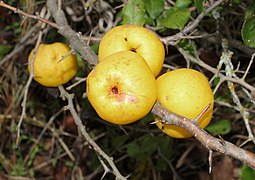Chaenomeles japonica
| Chaenomeles japonica | |
|---|---|

| |
| Scientific classification | |
| Kingdom: | Plantae |
| Clade: | Tracheophytes |
| Clade: | Angiosperms |
| Clade: | Eudicots |
| Clade: | Rosids |
| Order: | Rosales |
| Family: | Rosaceae |
| Genus: | Chaenomeles |
| Species: | C. japonica
|
| Binomial name | |
| Chaenomeles japonica | |
| Synonyms[1] | |
|
List
| |
Chaenomeles japonica, called the Japanese quince or Maule's quince,[2] is a species of flowering quince that is native to Japan.
It is a thorny deciduous shrub that is commonly cultivated. It is shorter than another commonly cultivated species C. speciosa, growing to only about 1 m in height. It is best known for its colorful spring flowers, which are red, white, pink or multicoloured.
Description
[edit]It is a bulky shrub with thorns and widely spreading branches, which reaches heights of growth of 0.6 to 2.0 meters. The leaves are lanceolate to obovate, roughly toothed and glabrous even when young. They are 4 to 5 inches long and 2 to 3 inches wide, including the petiole. The unusually large stipules are 1 centimeter long and 1.5 to 2 centimeters wide, kidney-shaped and serrated on the edge; they are only found on long shoots.[3][4]
It blooms in winter, before leaf budding; it blooms again in summer but with less abundance. Usually there are 2 to 3 flowers arranged together; they are coloured orange to brick red. When open, the flowers are 3 to 4 centimeters wide. The fruit is called Kusa-boke (草木瓜, Kusa-boke) in Japanese. It produces apple-shaped fruit, 4 to 7 centimeters in diameter, that are a golden-yellow color containing red-brown seeds.[5]
Uses
[edit]The fruit is edible, but hard and astringent, unless bletted or cooked. The fruits are not edible raw, but as with all fruits of the rose family, the pulp is non-toxic and the kernels contain small amounts of poison. The fruit is occasionally used in jam, jelly and pie making as a substitute for its cousin, the true quince, Cydonia oblonga. C. japonica is also popularly grown in bonsai.[6] It accepts all types of soil, but grows very slowly in calcareous soil.
Gallery
[edit]-
Flowers
-
Fruit
-
Whole plant
References
[edit]- ^ "Chaenomeles japonica (Thunb.) Lindl. ex Spach". Plants of the World Online. Board of Trustees of the Royal Botanic Gardens, Kew. 2017. Retrieved 12 December 2020.
- ^ English Names for Korean Native Plants (PDF). Pocheon: Korea National Arboretum. 2015. p. 406. ISBN 978-89-97450-98-5. Archived from the original (PDF) on 25 May 2017. Retrieved 4 January 2017 – via Korea Forest Service.
- ^ Herfried Kutzelnigg: Maloideae . In: Hans. J. Conert et al. (Ed.): Gustav Hegi. Illustrated flora of Central Europe. Volume 4 Part 2B: Spermatophyta: Angiospermae: Dicotyledones 2 (3). Rosaceae 2 . Blackwell 1995. ISBN 3-8263-2533-8
- ^ Bailey, L.H.; Bailey, E.Z.; the staff of the Liberty Hyde Bailey Hortorium. 1976. Hortus third: A concise dictionary of plants cultivated in the United States and Canada. Macmillan, New York.
- ^ Erich Oberdorfer: Plant-sociological excursion flora for Germany and neighboring areas . 8th edition. Verlag Eugen Ulmer, Stuttgart 2001, ISBN 3-8001-3131-5 . Page 501.
- ^ D'Cruz, Mark. "Ma-Ke Bonsai Care Guide for Chaenomeles japonica". Ma-Ke Bonsai. Retrieved 2021-02-04.



